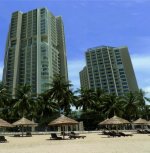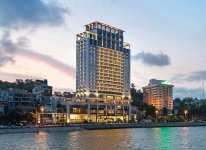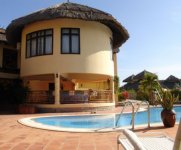
Vietnam is a country in South-East Asia, located on the coast of the South China Sea. It is famous for its beaches, rivers, Buddhist pagodas and lively cities. In the capital, Hanoi, there is a huge marble mausoleum of the famous leader of the Chinese Communist Party Ho Chi Minh. In the city of Ho Chi Minh City, which used to be called Saigon, you can find many buildings in the French colonial style, as well as museums dedicated to the history of the Vietnam War. The Kuti tunnels were often used by the Vietcong soldiers.
The southern coast
Vietnam’s convex southern coastline is lined with seemingly endless beaches that, for many, are reason enough to visit the country. The main resort areas of Nha Trang and Mui Ne have seen their popularity explode, and are now adding culinary sophistication and top-drawer accommodation to their coastal charms. There are also a number of less-heralded beaches to track down, and even a few islands, but the region also has historical significance – this was once the domain of the kingdom of Champa, whose magnificent ruins still dot the coast.
An Indianized trading empire, Champa was courted in its prime by seafaring merchants from around the globe, but steadily marginalized from the tenth century onwards by the march south of the Vietnamese. These days a few enclaves around Phan Thiet and Phan Rang are all that remain of the Cham people, but the remnants of the towers that punctuate the countryside – many of which have recently been restored – recall Champa’s former glory.
Despite the influx of tourism, sea fishing is the region’s lifeblood and provides a living for a considerable percentage of the population. Fleets of fishing boats jostle for space in the cramped ports and estuaries of the coastal towns, awaiting the turn of the tide; and fish and seafood drying along the road are a common sight. The fertile soil blesses the coastal plains with coconut palms, rice paddies, cashew orchards, sugar cane fields, vineyards and shrimp farms. One of the most commonly seen fruits here, especially around Phan Thiet, is the dragon fruit, which grows on plants with distinctive, octopus-like tentacles.
The central coast
The narrowest bit of the country holds an astonishingly dense collection of sights. From the south, you’ll come first to the town of Hoi An, highly traditional and hugely popular on account of its wonderful architecture, laidback air and superb culinary scene. Further north is Da Nang, whose bars, restaurants and sleek new buildings make it enjoyable in a more contemporary sense; however, it too boasts a wealth of nearby sights. Then there’s Hué, erstwhile capital of the Nguyen dynasty. A visit to the old Imperial City, with its splendid palace buildings and manicured gardens is like a taking a step into the past. Lastly are the sights pertaining to the American War in the famed Demilitarized Zone (DMZ). The area marked the divide between North and South Vietnam, which, some would argue, still exists today.
You’ll notice great differences in weather, cuisine, language and even local character to the north and south of the Ben Hai River, which runs through the DMZ. However, Vietnam was not always divided along this point – it was previously the Hoanh Son Mountains, north of Dong Hoi that formed the cultural and political line between the Chinese-dominated sphere to the north, and the Indianized Champa kingdom to the south. As independent Vietnam grew in power in the eleventh century, so its armies pushed southwards to the next natural frontier, the Hai Van Pass near Hué. Here again, the Cham resisted further invasion until the fifteenth century, when their great temple complex at My Son was seized and their kingdom shattered.
Ho Chi Minh City and around
Ho Chi Minh City – or Thanh Pho Ho Chi Minh, to give it its full Vietnamese title – is Vietnam’s centre of commerce and the country’s biggest city, though not its administrative capital – an honour that rests with Hanoi. As a result of the sweeping economic changes wrought by doi moi in 1986, this effervescent city, perched on the banks of the Saigon River and still known as Saigon to its eight million or so inhabitants, has changed its image from that of a war-torn city to one of a thriving metropolis, challenging Singapore, Bangkok and the other traditional Southeast Asian powerhouses. All the accoutrements of economic success – fine restaurants, flash hotels, glitzy bars and clubs, and shops selling imported luxury goods – are here, adding a glossy veneer to the city’s hotchpotch landscape of French stones of empire, venerable pagodas and austere, Soviet-style housing blocks.
Sadly, however, Ho Chi Minh City (HCMC) is still full of people for whom economic progress has not yet translated into food, housing and jobs. Street children roam the tourist enclaves hawking books, postcards, lottery tickets and cigarette lighters; limbless mendicants haul themselves about on crude trolleys; and watchful pickpockets prowl crowded streets on the lookout for unguarded wallets. Though the number of beggars is gradually declining, tourists must quickly come to accept them as a hassle that goes with the territory. In addition, the arrival, en masse, of wealthy Westerners has lured many women into prostitution, for which the go-go bars of Dong Khoi became famous during the American War.
Hanoi and around
By turns exotic, squalid, gauche and hip, the high-octane Vietnamese capital of Hanoi provides a full-scale assault on the senses. Its crumbly, lemon-hued colonial architecture is a feast for the eyes; swarms of buzzing motorbikes invade the ear, while the delicate scents and tastes of delicious street food can be found all across a city that – unlike so many of its regional contemporaries – is managing to modernize with a degree of grace. Despite its political and historical importance, and the incessant noise drummed up by a population of over six million, Hanoi exudes a more intimate, urbane appeal than Ho Chi Minh City.
Hanoi city centre comprises a compact area known as Hoan Kiem District, which is neatly bordered by the Red River embankment in the east and by the rail line to the north and west, while its southern extent is marked by the roads Nguyen Du, Le Van Huu and Han Thuyen. The district takes its name from its present-day hub and most obvious point of reference, Hoan Kiem Lake, which lies between the cramped and endlessly diverting Old Quarter in the north, and the tree-lined boulevards of the French Quarter, arranged in a rough grid system, to the south. West of this central district, across the rail tracks, some of Hanoi’s most impressive monuments occupy the wide open spaces of the former Imperial City, grouped around Ho Chi Minh’s Mausoleum on Ba Dinh Square and extending south to the ancient walled gardens of the Temple of Literature. A vast body of water confusingly called West Lake sits north of the city, harbouring a number of interesting temples and pagodas, but the attractive villages that once surrounded it have now largely given way to upmarket residential areas and a smattering of luxury hotels.









